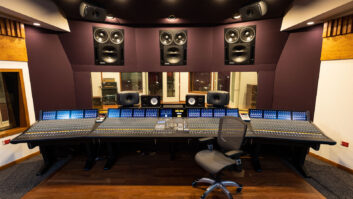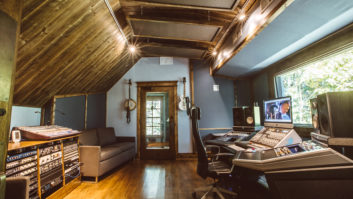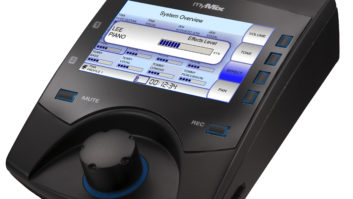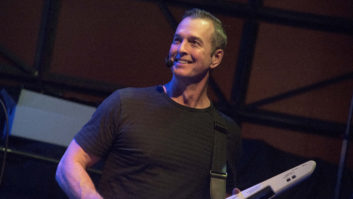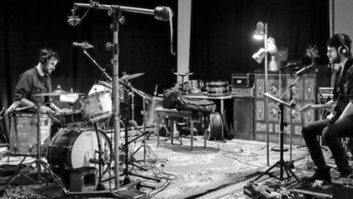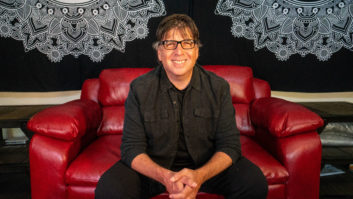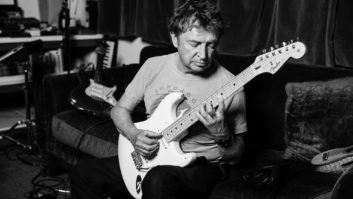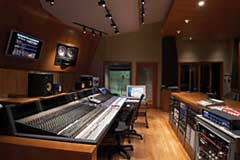

TIMBALAND
Top engineer Jimmy Douglass’ room at Timbaland Studios (Virginia Beach, Va.) is in a radically remodeled warehouse space owned by Tim Mosley and designed by the Walters-Storyk Design Group. The existing ceiling was removed to take the room height up to the ceiling of the building’s second floor in the live room, which also includes three iso booths. The facility’s main control room is built around a Neve VR Series console, a Yamaha DM2000 and custom Augspurger speakers. A second Pro Tools, 5.1 surround, MIDI mixing room (with its own iso booth) and first- and second-floor lounges are also available.

EARGASM STUDIOS
Eargasm is the music-recording wing of John Chominsky’s audio business, situated in the same office complex that houses Atlantis Group post-production. When Chominsky leased space for Atlantis six years ago, in a prime location one block from Santa Monica’s tony 3rd Street Promenade, he grabbed some extra square footage for a music studio, to be built once Atlantis (designed by Carl Yanchar of Wavespace) was going strong. When Chominsky took bids for the music room, he says, “Everyone said it would take six months to build. Because we would build our new room right next to Atlantis, we couldn’t afford to close for six months; nor could we afford sawdust, drills and hammers.” Chominsky found a solution with Lawrence P. Swist Designs firm, which also encompasses a manufacturing wing, Evenfall Acoustics. Larry Swist’s designs are custom built offsite and installed in a matter of weeks. “We manufactured all of the interior systems, including panels, diffusers, soffits and clouds, and coupled them to a metal isolation enclosure that was erected on a floating floor. It took ten days to install the isolation enclosure, five days for the interiors.”
Equipment at Eargasm includes a Digidesign ICON console — one of the first in L.A. — and a Pro Tools HD3 system rife with plug-ins. Engineers can also create analog submixes via API mixers, and monitor through Yamahas or Genelecs. Since the studio opened in March 2005, music clients have included Kathy Valentine (of the Go-Go’s) and Doug Fieger (The Knack) and video games such as Saints Row. Though the facility is growing, Chominsky and his core staff, Sean Graham and Jaimie Siedow, work in the same way they have for six years. “We all wear multiple hats,” Chominsky says. “This is a small shop where everyone knows how what they do will affect the next step.”

CLOUD 9 RECORDING
This music-recording studio in Long Island, N.Y., reopened in 2005 after a major overhaul designed and implemented by studio owners Joe and Jack Napoli, and their father, Joseph Napoli. The refurbished Cloud 9 control room is naturally illuminated by skylights. Control room and live room feature a floating nonparallel design, which incorporates omni- and bidirectional diffusion. Gear includes an Oram BEQ Series 24 inline console, which was custom modified by Andrew Roberts of Purple Audio. A custom Audio Excessories TT patchbay was built for the facility by Matt Marinelli of Coral Sound. Monitoring is via Genelec 1037A mains and Yamaha NS10 and Quested VS2205 near-fields, and the studio offers a nice collection of vintage mics and outboard gear, and vintage guitars, amps and drums.

STUDIO C AT STUDIOS PICCOLO
Studio C at Studios Piccolo (Montreal, Quebec, Canada) was redesigned and reopened in June of last year. The room is part of a five-studio complex that also includes a Neve music-recording studio (A), a 5.1 mix room (B), two smaller project rooms and a mobile rig. The C space was divided to include an iso booth, and the refurbished control room features an SSL AWS 900, installed in the center of a wrap-around workstation. This ergonomic design also includes Dynaudio BM15A main monitors, Pro Tools HD3 and a long list of plug-ins. Studio C was designed by owners Denis Savage and Dominique Messier, with Resonance Inc.

STUDIO B AT STUDIO 880
Green Day, frequent clients of John Lucasey’s Studio 880 (Oakland, Calif.), have claimed their own room at the facility. The Grammy-winning punk band arranged for the Walters-Storyk Design Group to redesign and refurbish 880’s formerly unfinished Studio B, which comprises a 600-square-foot control room, 800-square-foot live room and two iso booths. John Storyk’s design, completed last April, includes a suspended architectural cloud that absorbs low end and reflects mid- to high frequencies. Other acoustical elements include a series of black, gray and natural-wood panels, and a custom wood, rear-wall, full-frequency Diffractal diffuser. Studio B is equipped with an SSL 9064J console and a Pro Tools HD rig with Apogee converters. Monitoring is via Genelec 1038A, Yamaha NS10 and Dynaudio BM15 speakers. The facility also offers a collection of microphones from Sennheiser, Neumann, Telefunken and others.
CHICAGO RECORDING COMPANY
Sound designer Jeffrey Van Steen, formerly a staffer at CRC, worked with engineers at the venerable Chicago facility to create a new studio on West Wacker Drive: Chicago Recording Company • Secret Frequency, which opened in October 2005. Van Steen designed the rooms with architect/acoustical designers Klaus Koch and Cleon Wells to provide sound design, original music composition, audio post and 5.1 surround mixing services. It’s a unique arrangement wherein Steen provides creative services and CRC does all the post-production. Featured equipment includes Pro Tools HD2 Accel, Dynaudio 5.1 monitoring and Apple Logic Pro.

MARK MORGAN STUDIO
Film/TV music composer Mark Morgan’s new personal studio (Malibu, Calif.) is part of his newly built home overlooking the Pacific coastline. To compensate for a sideways-sloping roof in this writing/mixing room, design firm studio bau: ton called for a floating ceiling to be installed over the custom workstation. That ceiling, and most walls, are covered with charcoal-colored BAFP cotton batts, with painted wood strips in between. Equipment includes a Yamaha 02R console and Genelec 1031A main monitors. The studio pictured, which opened in February 2006, is phase one; a tracking room, separated from the mix room by a glass wall, is planned.

NEW ENGLAND INSTITUTE OF ART
This is the new 5.1 high-definition digital audio facility at the New England Institute of Art. Open in April of 2005, the studio is used by advanced students in the college’s Audio & Media Technology Bachelor of Arts program. Bill Crabtree and department faculty designed the studio, which is equipped for video post, mastering and surround mixing. Central to the studio are a Yamaha DM2000 housed in a custom console frame by Sound Construction & Supply, and 32 channels of Pro Tools HD3. There is Quested surround main monitoring, and a selection of outboard gear from TC Electronic, SSL (XL Logic surround compressor), Vintech and Summit.

UNIVERSAL MASTERING
When the Universal Music Group needed to replace its Edison, N.J., mastering studios, Francis Manzella’s FM Design firm was hired to design three new studios, a central machine room and production spaces. The newly built mixing/mastering suite is a 5.1 multipurpose facility with floating room shells and deep trapping for extended and smooth low-frequency response. RPG Diffusors are installed on front and rear walls, covering all five monitor positions. The new studios (B, C and D) are located in New York City and were completed last December. Each mastering room features a Pro Tools HD system with ProControl worksurface, and PMC surround monitoring with a Griffin LFE 15-inch subwoofer and Dangerous Music ST/SR monitor section.

DIGITAL ONE
Studio Pacifica designed three surround mix rooms within a new 8,000-square-foot audio/video post facility for Digital One (Portland, Ore.). Built into a 1960s structure, the studio design celebrates the mid-century modern architectural style with floor-to-ceiling windows, multiple lounges, hip working offices for clients and shag carpeting. The three surround mix rooms are identically equipped with Pro Tools HD, Yamaha 02Rs and KRK 7000B monitoring. The project is a joint venture with multiroom video post house Mission Control.

MASTERSUITE
Mastering engineer Jay Frigoletto relocated from L.A. to Brookline, N.H., a year and a half ago and completed his new studio, Mastersuite, in January 2006. The facility was designed by its owner and built by Ben Chandler of Studio Metronome in a new building at the Metronome Arts Complex. A large window at the rear of the studio provides vistas of the 100-acre hilltop property. Frigoletto uses a Sonic HD system, Lavry converters, Millennia, Pultec and Manley EQ, Manley and Chandler compression, and digital processing from Weiss, Sintefex, Massenburg and TC Electronic. Projects at the new studio have included releases from Oasis, Shinedown and Clutch, among others.

DNA STUDIOS
Pilchner Schoustal International designed this music recording and production studio in Woodbridge, Ontario, Canada, for brothers Chris and David Tedesco, who are studio builders as well as artist/engineers. The facility was conceived as a private project studio, but the owners soon let that notion go, as they found themselves hosting sessions with singer/songwriter Ron Sexsmith, producer David Bottrill and many others. The 29×22-foot live room features variable acoustics, plus a built-in P.A., turn-of-the-century piano and adjustable mood lighting. The control room is built around an SSL G Series console and custom Pilchner Schoustal MAXelle monitors.

JAMES NEWTON HOWARD’S STUDIO B
Another high-end composer’s room from designer firm studio bau:ton, James Newton Howard’s Studio B features a frosted-glass window that lets in plenty of light, and side-wall perforated Topperfo cherry wood panels. A custom workstation desk allows for the master keyboard and the Digidesign ICON D-Command mixer to be switched out, depending on whether Howard is busy composing music, or recording or mixing the score to films like King Kong. Howard also uses a G5 running Pro Tools HD, and Quested 2108 surround monitors powered by Bryston amps.

LAKEWOOD CHURCH MEDIA SUITE
The Russ Berger Design Group designed media rooms to provide broadcast audio for the 16,000-seat Lakewood Church in Houston, Texas. The 27,000-square-foot suite, which opened in July of last year, is on the top floor of a five-story building adjacent to the church and includes video and audio production control rooms, recording and post-production studios, editing and graphics rooms and a central machine room. The studio pictured features a Euphonix System 5 post-production console and an E-mu PARIS mixer, Genelec 1037C and 1031A monitors and a wide array of outboard processing.

GEOFF ZANELLI’S PRODUCTION ROOM AT REMOTE CONTROL STUDIOS
Studio bau:ton designed this personal studio for film composer Geoff Zanelli within Oscar winner Hans Zimmer’s Remote Control Studios (Santa Monica, Calif.). Zanelli’s main production system is a G5 running Logic Audio Platinum; he also uses a G4 with Pro Tools for mixing, video playback and hard disk recording. Monitoring is via a Quested 5.1 system with an Event subwoofer. Also of note: a Doepfer keyboard built into the desk by Bob Merritt, and a great guitar collection (Les Paul, “bastardized” Strat, Everett steel string, Aria nylon string).

E LABS MULTIMEDIA
In June 2005, E Labs Multimedia (Madison, Wis.) opened in the space formerly occupied by Effigy Studios. This 3,000-square-foot facility is divided into two studios; pictured is the control room of Studio A, which also comprises a large live room and three iso booths. E Labs was designed by Jack LeTourneau (the studio’s chief engineer) and Jerry Neviaser. New equipment includes the Digidesign Control 24 mixing console with 16 channels of Focusrite microphone pre’s. The studio continues to employ Effigy’s JBL LSR6328 surround monitoring with LSR6312 subwoofer. One of the reopened studio’s first projects was “Timespace, the Infinite Adventure,” a presentation of Chicago’s Adler Planetarium.

REDEMPTION STUDIOS, CLIFTON, N.J.
Redemption Studios owner Mike Pilken says that his original concept for the facility, which opened in May of 2005, was for a small studio that would cater to local music-recording clients. But that vision grew considerably during the design process with the Walters-Storyk Design Group. The finished facility includes two studios; control room A centers around a Neve VR60 console and Genelec main monitors, and the attached large, live room (pictured) and drum booth feature Custom RPG diffusors. Studio B is a Pro Tools HD3/Genelec room. Redemption also offers a nice mic collection, including Neumann U87 and matched pairs of TLM 103 and SKM 184s, a wide range of outboard gear and a seven-piece TAYE Studio maple drum kit.

R!OT ATLANTA
Pictured is one of three new 5.1-capable suites opened at R!OT Atlanta in May 2005 and designed by Bret Thoeny of BOTO Design with acoustical engineering from Marshall Long Acoustics. Construction of the new studios was phased so that the new studios could be gradually installed while work continued in the facility’s existing rooms. Major equipment includes a Fairlight DREAM Constellation, ADAM 5.1 monitoring, and a wide range of outboard gear from Empirical Labs, Great River, Avalon, Lexicon, Eventide and Kurzweil. R!OT Atlanta is a full-service audio facility, providing sound design, stereo and surround mixing, music and voice-over recording, ADR and electronic spot delivery.

RIGHT TRACK/SOUND ON SOUND D1 PRODUCTION ROOM
The merging of Right Track with Sound on Sound (New York City) was one of the biggest audio news stories of 2005. Larry Swist redesigned the newly formed Right Track/Sound on Sound’s facility on West 38th Street in Manhattan for a December 2005 grand reopening. The studio was gutted and rebuilt as a Pro Tools HD4 Accel Room with Tannoy System 1200 main monitors and Tannoy PS350 subwoofer. Designed to be used for music production and overdubbing, the new Right Track/Sound on Sound Studio D1 has already hosted sessions with Mariah Carey, Maurice White, Nas and more.
For more studios that earned honorable mentions in the Class of 2006, visit
www.mixonline.com
and click

Class of 2006
Honorable Mentions

Photo by Carl Tatz
The Panic Room
This personal production room is a home studio designed and built by Carl Tatz Design for Rascal Flatts guitarist Joe Don Rooney. Sound isolation from the rest of Rooney’s Nashville home was critical to the design; Tatz achieved this by suspending the entire 11×12-foot control room from rafters above. There is an iso/vocal booth that also serves as an amp closet. Equipment, which was provided by Audio One (Nashville), includes Digidesign Control|24 in a custom Sound Construction frame, Pro Tools HD3 Accel, Aviom cue system, Apogee Big Ben, and processing from Neve, Universal Audio, Martech, Avalon, PreSonus, Tube-Tech and SPL. The PhantomFocus monitoring system includes Dynaudio BM-15As, NHT subwoofer, and Meyer and Ashly processing. Read next month’s “Recording Notes” for a story on the recording of Rascal Flatts’ Me and My Gang.

Photo by James F. Wilson
Circle R Media
The Russ Berger Design Group is proud of the LEED (Leadership in Energy and Environmental Design) certification received by this 48,000-square-foot video, film and audio production complex in Fort Worth, Texas. Originally developed as a part of RadioShack Corporation, Circle became an independent, privately owned facility in 2005. It comprises nine video/audio edit suites, video and audio production control rooms, audio post-production and recording sound booths, a master control room and three soundstages. Some of the equipment on offer at this media megaplex include Pro Tools HD1 and HD2; a tremendous supply of mics from Neumann, Audio-Technica, Schoeps, AKG, Sennheiser and Sony; and Tannoy and Genelec surround monitoring systems.

Firehouse 12 Recording
This combination live performance space/recording studio features a warped, 3-D plywood membrane absorber for the 18-foot live room ceiling and custom-built glass doors. Firehouse 12 (New Haven, Conn.) is set in a 1904 building that is listed on the National Register of Historic Places, and designer John Storyk says that he and studio owner, Nick Lloyd, “immediately recognized its terrific inherent acoustics.” Featured equipment includes a vintage API 48-input console, Studer A827 2-inch tape machine, 48 channels of Pro Tools HD3/Accel, Nexo PS 15/PS 10 speakers with Camco amplification, and a wide selection of mics and outboard gear.
